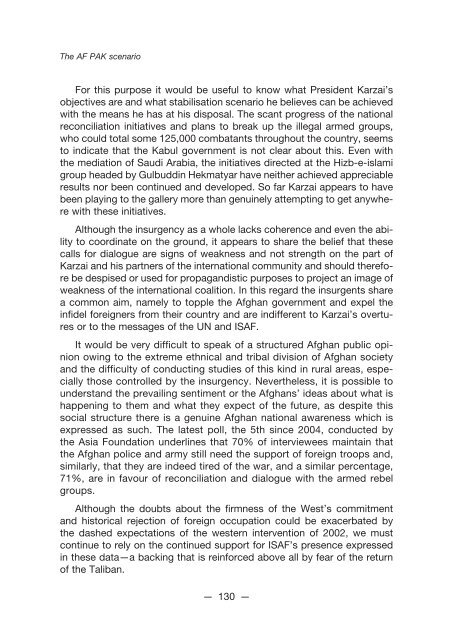Strategic Panorama 2009 - 2010 - IEEE
Strategic Panorama 2009 - 2010 - IEEE
Strategic Panorama 2009 - 2010 - IEEE
Create successful ePaper yourself
Turn your PDF publications into a flip-book with our unique Google optimized e-Paper software.
The AF PAK scenario<br />
For this purpose it would be useful to know what President Karzai’s<br />
objectives are and what stabilisation scenario he believes can be achieved<br />
with the means he has at his disposal. The scant progress of the national<br />
reconciliation initiatives and plans to break up the illegal armed groups,<br />
who could total some 125,000 combatants throughout the country, seems<br />
to indicate that the Kabul government is not clear about this. Even with<br />
the mediation of Saudi Arabia, the initiatives directed at the Hizb-e-islami<br />
group headed by Gulbuddin Hekmatyar have neither achieved appreciable<br />
results nor been continued and developed. So far Karzai appears to have<br />
been playing to the gallery more than genuinely attempting to get anywhere<br />
with these initiatives.<br />
Although the insurgency as a whole lacks coherence and even the ability<br />
to coordinate on the ground, it appears to share the belief that these<br />
calls for dialogue are signs of weakness and not strength on the part of<br />
Karzai and his partners of the international community and should therefore<br />
be despised or used for propagandistic purposes to project an image of<br />
weakness of the international coalition. In this regard the insurgents share<br />
a common aim, namely to topple the Afghan government and expel the<br />
infidel foreigners from their country and are indifferent to Karzai’s overtures<br />
or to the messages of the UN and ISAF.<br />
It would be very difficult to speak of a structured Afghan public opinion<br />
owing to the extreme ethnical and tribal division of Afghan society<br />
and the difficulty of conducting studies of this kind in rural areas, especially<br />
those controlled by the insurgency. Nevertheless, it is possible to<br />
understand the prevailing sentiment or the Afghans’ ideas about what is<br />
happening to them and what they expect of the future, as despite this<br />
social structure there is a genuine Afghan national awareness which is<br />
expressed as such. The latest poll, the 5th since 2004, conducted by<br />
the Asia Foundation underlines that 70% of interviewees maintain that<br />
the Afghan police and army still need the support of foreign troops and,<br />
similarly, that they are indeed tired of the war, and a similar percentage,<br />
71%, are in favour of reconciliation and dialogue with the armed rebel<br />
groups.<br />
Although the doubts about the firmness of the West’s commitment<br />
and historical rejection of foreign occupation could be exacerbated by<br />
the dashed expectations of the western intervention of 2002, we must<br />
continue to rely on the continued support for ISAF’s presence expressed<br />
in these data—a backing that is reinforced above all by fear of the return<br />
of the Taliban.<br />
— 130 —

















